
Btrax Design Company > Freshtrax > 2019 Media Tren...
2019 Media Trends in Japan: How Old Media is Staying Relevant
Is traditional media such as radio, newspapers or TV going to be a thing of the past? In Japan, traditional media is facing issues of declining viewership and revenue in this new age of how Japanese are consuming media. However, some are getting creative to stay relevant by leveraging new technologies and incorporating new media (media that is native to computers/internet) into their ecosystems.
In this article, we will explore some of traditional media’s creative and innovative survival strategies and how they are working in the Japanese market.
Radio
In the United States, 93% of U.S. adults listen to the radio every week. On the other hand, according to research conducted by NHK in November 2018, only 32.5% of Japanese listen to the radio on a weekly basis. This number dropped from the previous year by 2.4%, with the radio audience population decreasing since 2008.
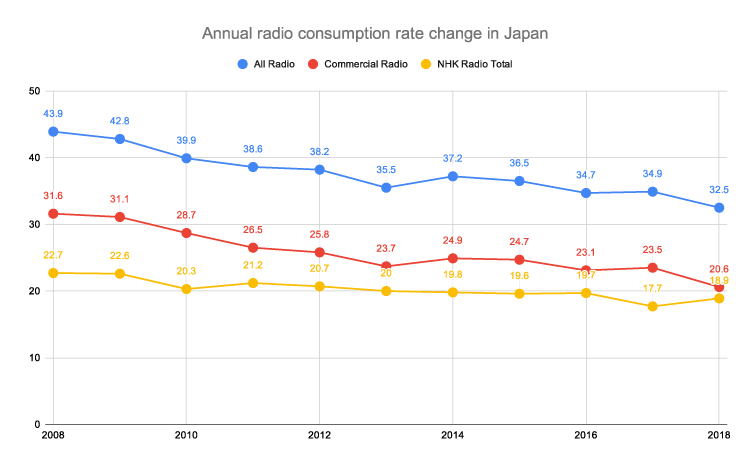
Source: NHK
It may seem counterintuitive with the decrease in listeners but radio is seeing a slight increase in company ad budgets, while ad budgets for the other old media such as TV, magazines, and newspapers have been decreasing, according to Toyokeizai online. Even though the number of listeners continues to decrease, the increased amount spent on radio advertising indicates that companies see audio media as an effective way to interact with audiences, especially younger ones.
The main reason for this increase is the prevalence of smartphones and smart speakers and people using services like “radiko” to listen to radio programs on their digital devices.
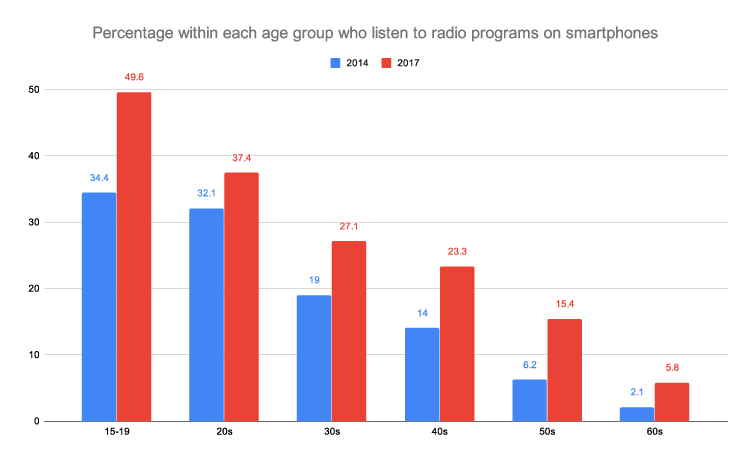
Source: Dentsu
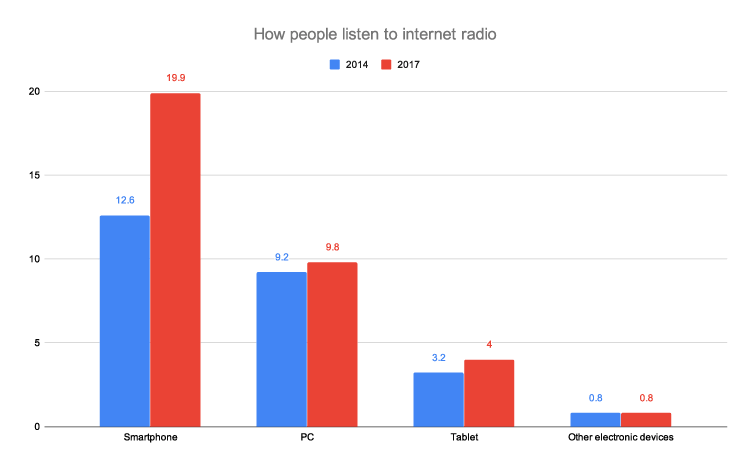
Source: Dentsu
radiko: Allows users to listen to radio programs on smartphones
radiko is an Internet protocol, simulcast radio service that enables users to live stream local radio programs through computers, smartphones, smart speakers and other devices connected to the internet. For example, if you are in Tokyo, the free radiko service only allows you to listen to programming that is in the Tokyo area. As of November 2018, programs from 93 Japanese radio stations are available on the radiko platform.
radiko allows users to listen to archived radio programs that broadcasted in the past week. Users can listen to these archived programs up to 3 times within a 24 hour time frame, enabling them to listen to programs they missed. Paid members (~$3 USD/month) can listen to radio programs, regardless of location.
According to radiko’s media kit, it has 1.2 million to 1.3 million daily unique users and individual users listen to radio programs through radiko for about 130 minutes a day. Currently, 550,000 users are paid members. The average age of radiko users is 44.4 years old, while the average age of a listener of traditional radio is 52.4 years old. Looking at the chart below you can see that radiko has a higher user share among men under 20 years old and women under 30 years old compared to traditional radio.
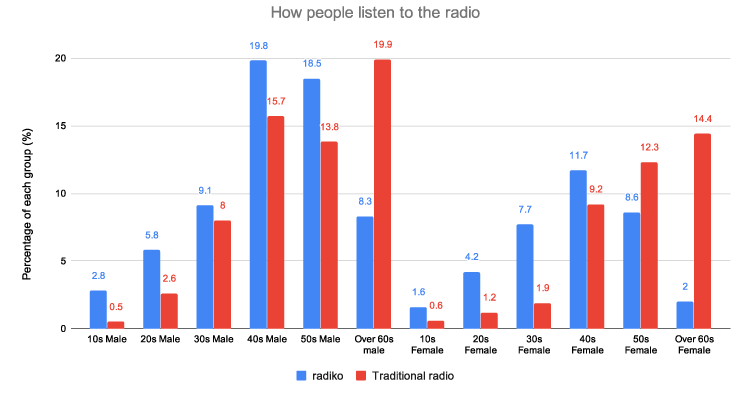
Source: radiko media kit
In 2018, radiko started an audio ads program, which enables advertisers to target specific user segments to promote their brand and/or service. radiko has developed and is still improving its DMP (Data Management Platform) to collect, store, analyze and integrate the information they have about users such as favorite programs, radio app usage, premium member user demographics along with third party data like online purchase history for better user targeting. In this way, brands are now able to not only interact with the relatively younger generation more so than traditional radio, but also people have better connections with the brands, which improves marketing efficiency.
Voicy: Audio blog with programming by influencers and experts
There is another notable new audio media that emerged recently and is growing rapidly in Japan. Voicy is an online audio content platform that distributes spoken audio episodes. It is very similar to podcasts, but the biggest difference is the program hosts. Only people who are approved by Voicy have their own channels on Voicy, as opposed to podcasts where anyone can create and distribute their own programs. In that sense, programs on Voicy are similar to regular radio programs that maintain certain quality standards. Limiting who can be a host enables Voicy to provide high-quality content for listeners. Hosts on Voicy are influencers or experts in a specific field/industry creating content ranging from news to business, language, technology, and lifestyle.
Newspapers
In Japan, 96% of newspapers are directly delivered to subscribers via home delivery networks of newspaper distributors. Aside from the five national newspapers, Yomiuri, Asahi, Mainichi, Nikkei, and Sankei, there are regional newspapers that cover specific areas such as prefectures and specialty newspapers, that cover specific industries or topics.
Although the newspaper is still the most significant form of paper media in Japan, it is also seeing a downtrend of newspaper subscribers. As the data shows below, newspaper revenues including circulation, advertising, and other types of revenue are declining. Newspaper circulation volume has been declining every year since 2000.
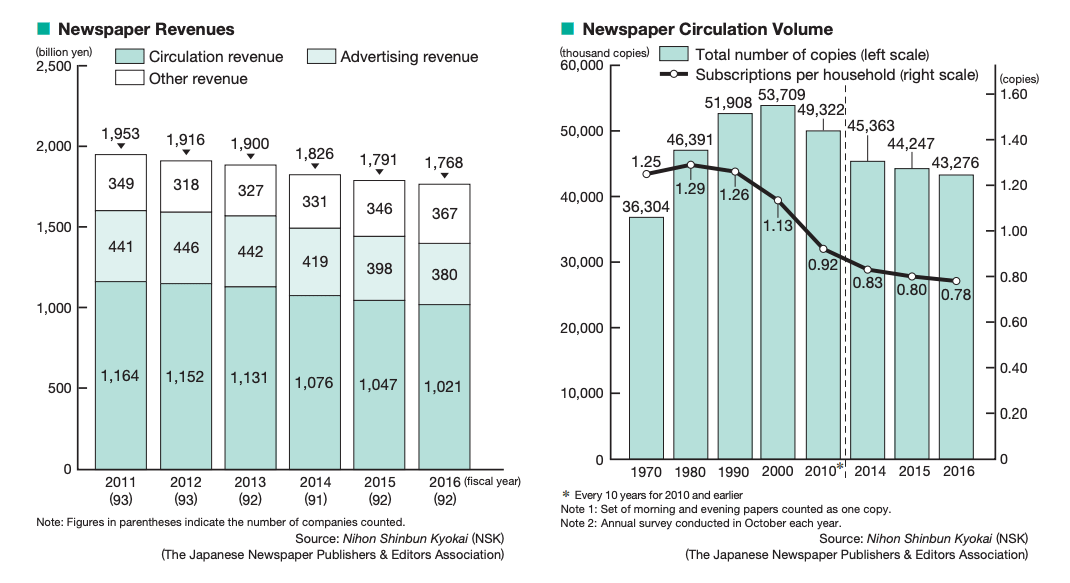
Source: Information Media trend in Japan 2018
This is because more and more people are browsing news on their mobile devices. While major newspapers have started distributing their content online, they are still losing viewers to news curation services such as Yahoo! News, LINE NEWS, SmartNews, and NewsPicks. It is expected that more than 87 million people will read news using news apps and/or online news sites in 2019.
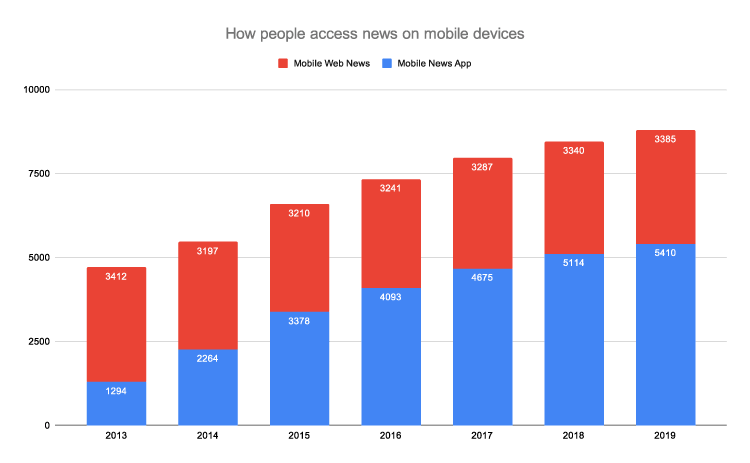
Source: ICT Research & Consulting
On the other hand, it is worth noting that only 9.4% of newspaper subscribers (including digital editions) read news online. Even though each newspaper publisher has put a lot of effort into digitizing content and promoting reading news online, the majority of subscribers, mostly the older generation, still prefer to read a physical newspaper.
Mercari used “newspaper extras” to promote the new imperial name era name
In Japan, “newspaper extras”, called “号外 (go-gai)” in Japanese, are normally distributed for free on the streets to quickly share breaking news such as accidents, disasters, and sports game results.
Mercari, a company that offers Japan’s largest consumer-to-consumer (C2C) marketplace, held a huge promotional event when the Japanese government announced its new imperial era name at around 12 pm on April 1st. The event took place in Shibuya, one of the most crowded places in Tokyo. Right after the government announced “Reiwa” as the new name of the era, Mercari staff started to print out the new era name on t-shirts and hand them out in a similar fashion to how newspaper extras are distributed, to inform people of the new imperial name.
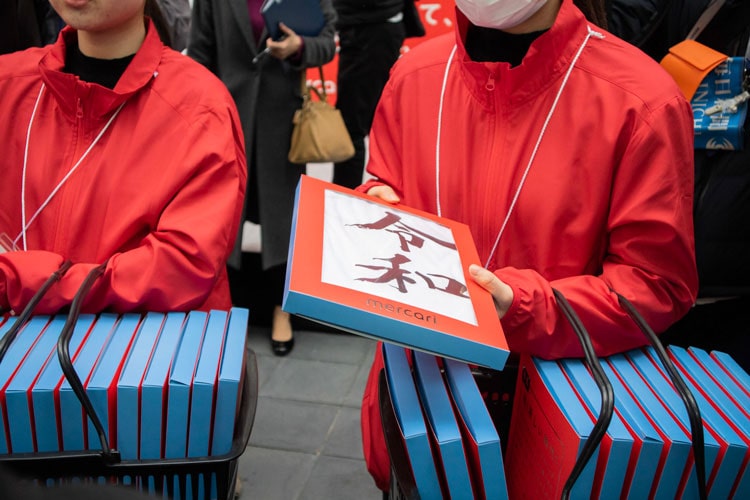
Image credit: fashionsnap.com
People who happened to be in Shibuya were able to experience the “once in a lifetime” occasion, by celebrating the new era with strangers, and with any luck, getting limited edition t-shirts.
You might be wondering why Mercari, a C2C resale app company, would host this event and distribute shirts. The key to understanding their strategy is the fact that they handed out only 500 copies of the “extra edition” Reiwa t-shirts to add to the value of scarcity. The company intentionally encouraged the lucky 500 people who received the t-shirts to sell them on Mercari. And that they did! Some of them were sold for as much as $80!
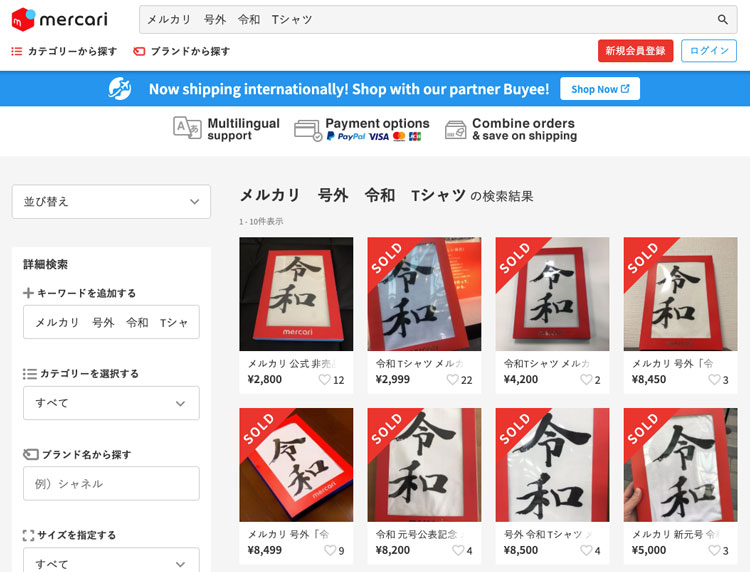
Source: mercari
Through this campaign, Mercari was able get some great media coverage. They also succeeded in getting people to use their service with many of the shirts, featuring the new empire era name, being sold on Mercari.
Pokémon GO’s “Go-gai”
Pokémon Go is an augmented reality mobile game that allows players to catch Pokémon characters in real life. In Pokémon Go, an event called “Community Day” is held once a month, and a specific Pokémon will show up in large quantities for a specified amount of time.
On April 13th, 2019, newspaper extras handed out by Sankei Sports newspaper informed people of the outbreak of Bagon, a Pokémon character, with the extras being given out at 15 major train stations throughout Japan. Pokémon Go utilized the newspaper extras to promote the community day as if it were breaking news (It definitely was breaking news for players!)
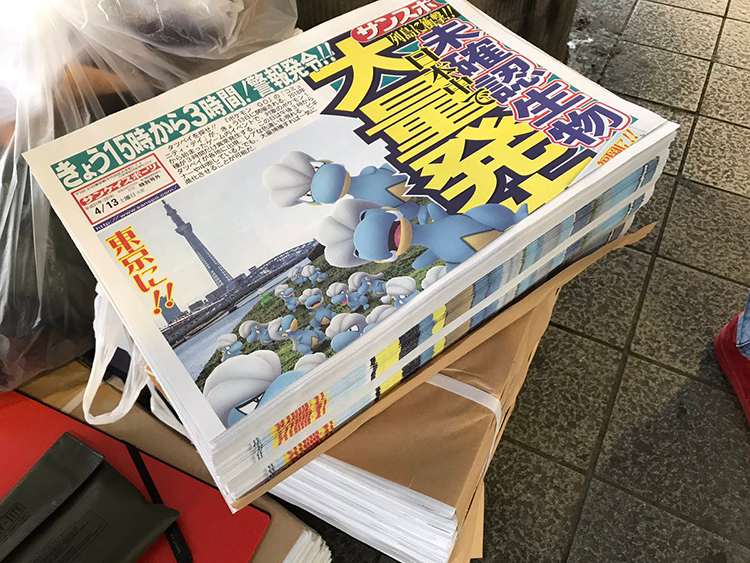
Image credit: @naomedia
The newspaper covered everything people needed to know about Pokémon Go, such as how to download the app and how to play Pokémon Go on “Community Day”. It also described how to capture Bagon using the app. The content was very simple and easy to understand, even for people who didn’t know about Pokémon GO and the Pokémon series. This was a great promotion to increase awareness of the app.
Kincho’s newspaper ad intended to be shared on social media
Kincho, a Japanese manufacturer that mainly produces household pesticide products, published a full-page ad in Japan’s major national newspapers. The ad was titled “The ultra-difficult origami” which had many lines showing where to fold on a black background.
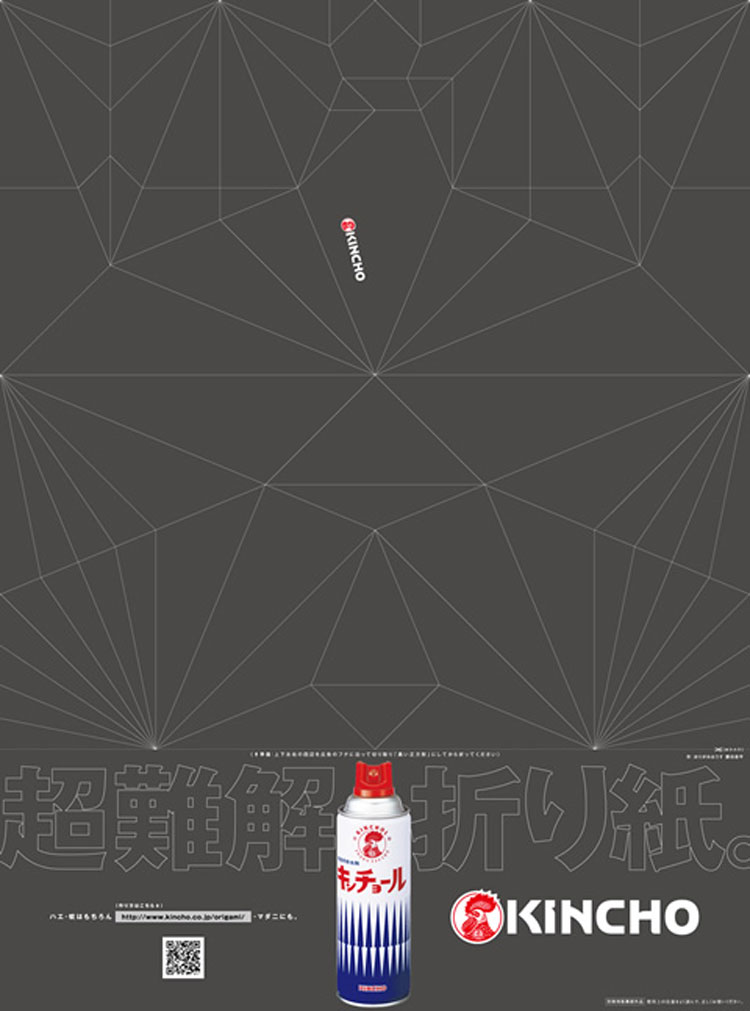
Image credit: Kincho
Readers could not see what they were making with the newspaper sized origami until the final folds were done, showing a giant cockroach!
なんちゅうもん作らせてくれたんじゃキンチョール‼️ pic.twitter.com/8jJ3BIxdQN
— mt (@tsurubaramt) May 27, 2017
People could not help but share their final product on social media. Not only was it difficult to make, with an average of about 50 minutes to finish, but the roach was very detailed and realistic. On that day, many Twitter timelines were filled with giant black roaches, encouraging others to try the origami challenge. Kincho successfully leveraged offline media to generate online buzz. If you are interested in making an origami roach, you can download the guided origami file from here.
TV
The TV broadcasting networks in Japan consist of public broadcaster, NHK, a network that is funded by fees collected from every household and business with TV receiving equipment, and commercial broadcasting companies that are supported by advertising. There are 127 commercial broadcasting companies in Japan and most of them are affiliated with the five key stations based in Tokyo; NTV, EX, TBS, TX, and CX. Subscribing to multi-channel platforms, like satellite TV, is not popular and its penetration rate is only 20%. As available TV programs are limited, the influence of TV has been and still is big in Japan, despite a decrease in viewership.
The 7 pm to 10 pm prime time viewing slots have been seeing viewer numbers decrease since 1997. The percentage of households that view a TV program live once hit 71.2% in 1997, but recently hit the lowest percentage, 59.9%, in 2017 and has stagnated over the last few years.
The main reason for TV’s decline in popularity is the recent saturation of content caused by the Internet. Before Netflix and YouTube emerged, TV was one of the few entertainment options that people could enjoy at home. However, that has changed and now people have access to an abundance of content, including social media. Also, the way TV distributes content no longer fits people’s diverse and on-the-go lifestyle. They want to consume content from anywhere and at any time, mostly from their mobile devices, while TV programs still require users to be in front of a TV on a fixed schedule. These obsolete requirements make it harder for people to keep up with TV shows. If viewers miss an episode of a TV drama series once, most of them won’t bother to watch the show again.
TVer: Allows users to watch 200+ Japanese TV programs on-demand for free
TVer is an online video streaming platform that allows users to watch more than 200 Japanese TV programs from their mobile devices and web browser for free. In 2015, the aforementioned Japanese five key stations partnered with each other to launch this service with the purpose of reaching more viewers who prefer to consume content on mobile devices.
The total number of content views in June 2019 was 73.65 million and the number of monthly active users was 8.17 million, both of which were the highest numbers since TVer launched. The awareness of the service among viewers aged 15 to 69 is 56.0%. The awareness among women from 25 – 49 increased by 1.7 points since March 2019, due to the popular TV dramas that are available on the platform.
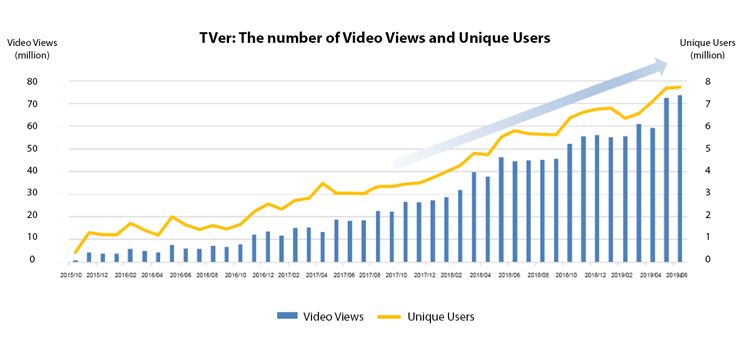
Source: TVer
TVer succeeded in gaining popularity by allowing users to watch TV programs, even if they missed a show as long as they watched it within 7 days after the showtime. As it was explained earlier, TV programs on the key stations were originally only available to watch on TV at a fixed time, but not anymore. TVer completely changed how people watch TV programs.
TVer has also become a great marketing channel for advertisers. Advertisements are inserted into the beginning, middle and end of a TV program, and they are not skippable. According to TVer’s media kit, the video completion rate of these ads are 93.6%, which is much higher than the average video ad completion rate of other video ads in Japan where completion ranges from 56.8% to 33.7% on desktop and mobile, respectively. Advertisers can insert video ads into a specific TV program or category, or at random.
Japanese TV shows interact with viewers by using social media
Another way Japanese TV shows are interacting with users is by creating social media content that is linked with a TV drama’s story. A TV show’s team runs social media accounts as if the characters in the show are using the accounts in real life.
“Ossan’s Love”, a Buzzword award-nominated, popular TV drama series broadcast in 2018, used Instagram in a very creative way. An Instagram account was created for one of the main characters, Musashi, where he created and posted pictures of his daily life beyond what was seen on TV. The content was all made up as if the character was an actual person living in the real world.
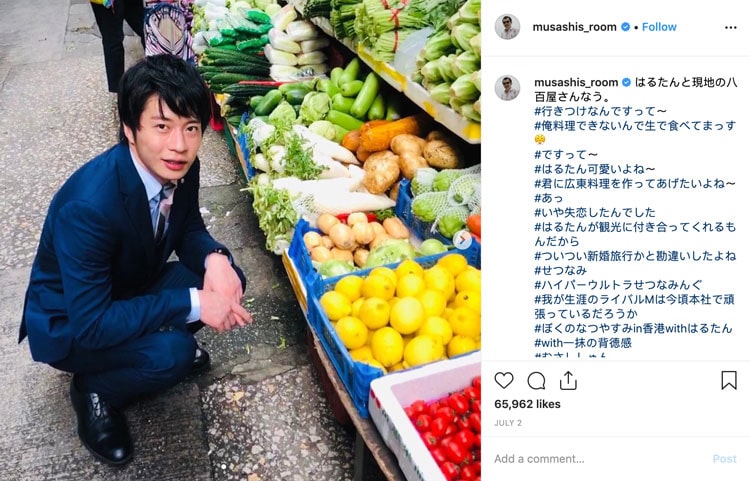
Image credit: @musashis_room
The posts on the Instagram account reflects his personality in the show; the ways he writes captions, uses hashtags (he likes to use very long sentence-like hashtags), and takes photos (most of his pictures are of Haruta, the man Musashi has a crush on.)
By taking advantage of real-life social media to bring the TV show’s characters into “our” life, the TV show succeeded in making the show more real and increased audience engagement. The Instagram account has over 4 million followers telling us how successful this experiment and show was.
Final thoughts
The media landscape in Japan has drastically changed over the past decade, due to the rise of social media and internet-enabled services. Although the audience base of traditional media has been shrinking, they still have quite a bit of influence and continue to have a lot of subscribers. In Japanese media culture, using strategies that integrate old and new media can help you reach a large audience and increase brand engagement.
If you are looking for the right media mix for your target customers in Japan, contact us! Our bilingual and cross-cultural team based in San Francisco and Tokyo can assist you in creating the most engaging media strategy for your brand.
Did you enjoy reading our article? Sign up for our newsletter to receive the latest articles in your inbox!
Edit by: Wakana Morlan







